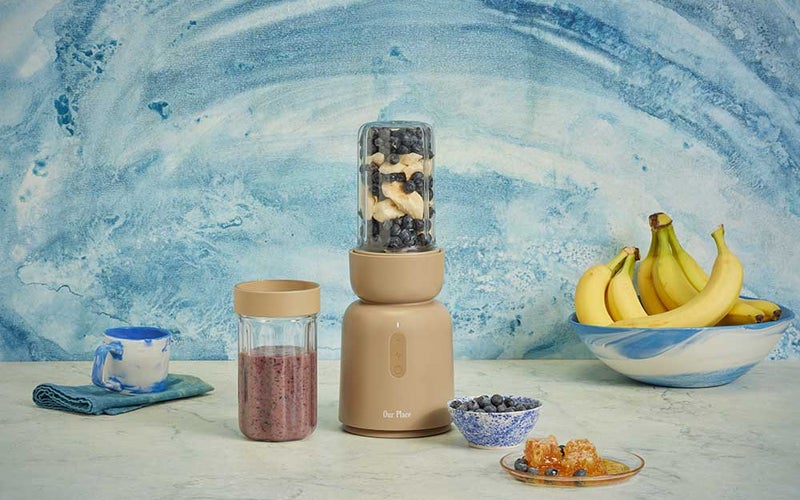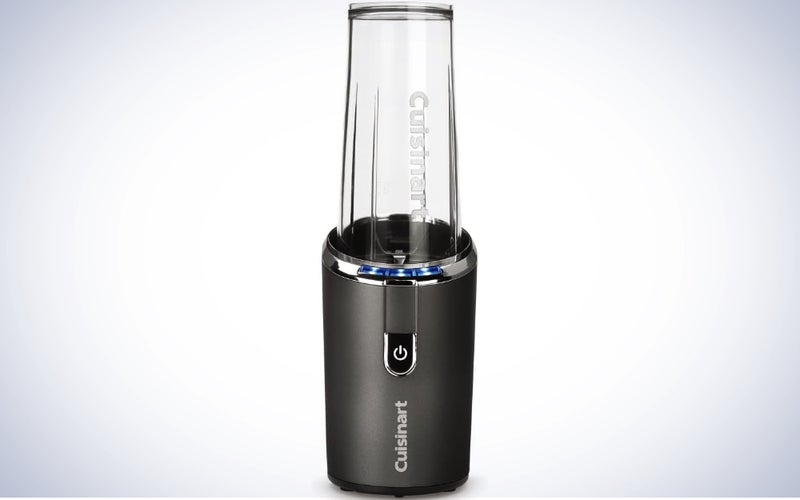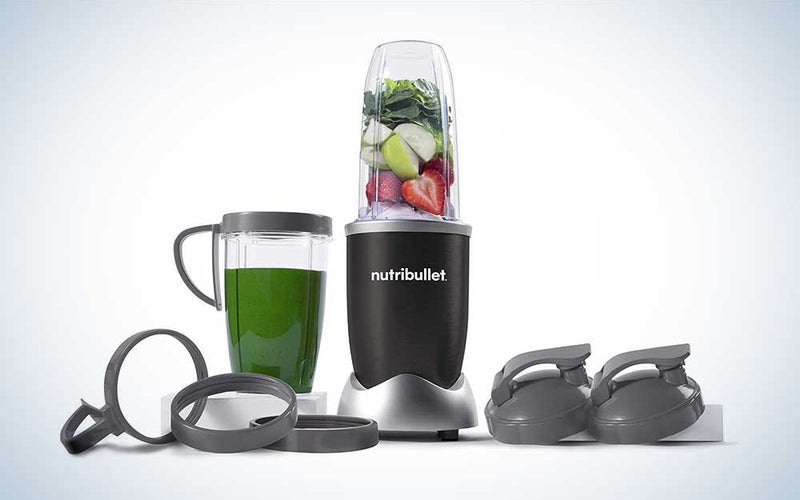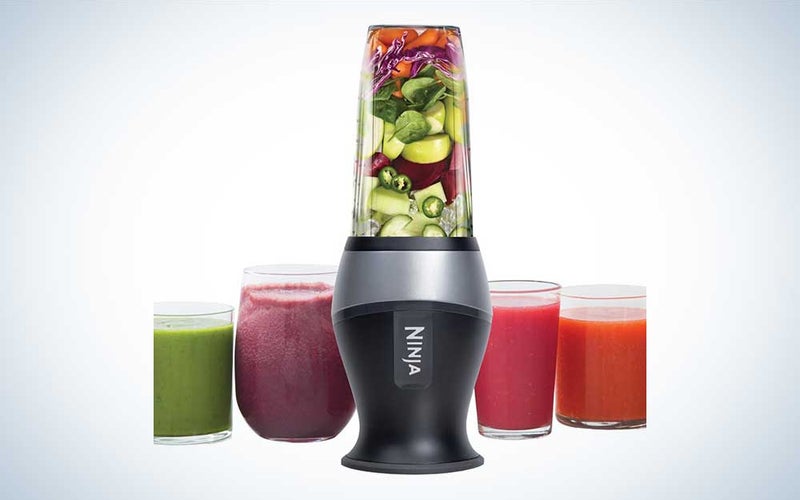We may earn revenue from the products available on this page and participate in affiliate programs. Learn more ›
A personal blender is perfect if you’re making smoothies, soups, and even frozen cocktails for one. They pack many of the same features as full-sized blenders in a pint-sized package that’s perfect if you’re low on counter space. As an apartment dweller who has lived in college crustzones, old buildings with no dishwashers, and slightly more suitable places, a personal blender has saved me plenty of time, space, and money. I don’t make so much smoothie that some goes to waste because I forget about it in my fridge. Plus, in my experience, personal blenders are easier to clean than their full-sized counterparts. More often than not, you can just throw in some soap and water, re-run the blender, rinse, and use it again the next day … or for your next meal. The best personal blenders fit neatly onto countertops and in cabinets without skimping on power.
How we chose the best personal blenders
This isn’t our first time at the blender rodeo. We’ve taken a spin through the best blenders and know what makes a certain blender a cut above the rest. We made sure each personal blender had at least 700 watts of power, with a focus on anything around 900 watts. In our experience, anything in the 700-900W range is capable of crushing ice and smoothing even the most freezer-burned bananas. We conducted our own testing—I’ve consumed a lot of liquid foods in the process of researching and writing this story—and made sure also to consult the reviews to get a full picture of the personal blenders’ power.
The best personal blenders: Reviews & Recommendations
Blending something into a slurpable slop is a great way to consume more fruits and vegetables, and a personal blender is an easy conduit to make it happen. One of our choices should help you treat your body more like a temple and less like a garbage disposal.
Best overall: Ninja BL660 Professional Compact Blender
Specs
- Dimensions: 17 x 6 x 8 inches
- Capacity: 16-ounce personal cup; 72-ounce blender
- Wattage: 1,110 watts
Pros
- Powerful
- Two kinds of blenders in one
- Doesn’t take up much space on counter
Cons
- Blades can miss small grains like chia and flax seeds
I am a creature of habit, and my morning breakfast has been the same for about a year. I’m a person who doesn’t love a huge meal first thing in the morning, so I tend to gravitate toward a protein-rich, fruit-forward smoothie. I’m not a gatekeeper, so my recipe is 1/2 of a frozen banana (a whole one if you want a creamier texture); Aldi brand Cherry Berry mix to my heart’s content (the best frozen fruit blend, in my opinion); a big spoonful of full-fat Greek yogurt for that magical protein (or a scoop of your favorite vegan protein powder); and enough orange juice to get it smooth, but not liquidy, which is usually to the max fill line. That morning breakfast smoothie gets made in this Ninja BL660 Professional compact blender, which isn’t showing any signs of slowing down after a year of daily use.
It has a 1,100-watt motor, which is more than enough to demolish fruit chunks. My frozen bananas get frozen because of my freezer, which makes things frosty at even the lowest setting, and I’ve never had a chunky smoothie in my time making them with this blender. It comes with two personal 16-ounce blender cups and a full-sized 72-ounce blender attachment for larger meals. The cups are made of tough BPA-free plastic and are dishwasher-friendly. There are four speed settings—three presets and a pulse button—along with a separate speed button for the single-serve cups.
I would take this blender with me on an island if I had to. However, there are moments when the chia seeds in my smoothie aren’t as pulverized as I’d like them to be. The same goes for larger flax seeds. It’s not a major problem for me, but the grainy texture sometimes gives me the ick, which makes me … not finish the smoothie. I know I’m not alone in getting grossed out by that kind of texture.
If you’re also looking for something with a food processor attachment on top of personal blending cups and blender, Ninja has a blender with all three that’s similar to the BL660.
Best design: Our Place Splendor Blender

Specs
- Dimensions: 5.5 x 6.1 x 8.5 inches
- Capacity: 750 mL for personal blender
- Wattage: 1,000 watts
Pros
- Stylish
- Incredible blend capabilities
- Easy to use
Cons
- Quality control and user experience issues
If you’d rather have a blender meant to be shown off rather than hidden in a cabinet, the Our Place Splendor Blender is the most stylish blender we found. It comes in colorways that match Our Place’s other products, like its Wonder Oven (which we included in our smart oven roundup) and the famous Always Pan.
The Splendor Blender isn’t just a pretty face. It packs 1,000 watts of power that demolished even the smallest of chia seeds in less than a minute. Although it only has two settings—pulse and blend—the “blend” option ramps up speed over the course of 45 seconds. The max fill line is 16 ounces, but there is some extra wiggle room between the fill line and the blender base, so it’s more forgiving than other personal blender systems. I was reaching for this blender over the Ninja BL660 for a period of time, based on its ease of use and ultra-smooth blending abilities.
Go deep into the reviews of the Always pen, and you’ll see complaints about the pan’s value, with customers saying it doesn’t perform the way a $145 pan should. Sadly, the Splendor Blender faces similar issues. Although I was deeply impressed with the Splendor Blender’s blending abilities, there are some quality control and user experience issues. The blade itself stuck after one month of use. This prevented me from using the blender since the blade couldn’t turn and, thus, couldn’t lock. In the process of attempting to lock the blender, the thin blender handle started to break. Additionally, the blade base got stuck in the blender cup and nothing—no hot-to-cold water switch, no amount of manpower, no internet hack—got it unstuck. The blender’s light blinks when not in use, which is annoying. You have to unplug the blender to stop this issue. There is a one-year warranty and a 100-day return window if you’re not happy with your purchase, and Our Place rectified my situation with a new unit. When the Splendor Blender works, it’s incredible; when it doesn’t, it’s disappointing. I have hope, however, that a Splendor Blender 2.0 would alleviate these pain points for an even better blending—and user—experience.
Best portable: Cuisinart RPB-100 EvolutionX Cordless Rechargeable Compact Blender

Specs
- Dimensions: 3.5 x 3.9 x 11.69 inches
- Capacity: 16 ounces
- Wattage: N/A
Pros
- Portable
- Easy to use
- Dishwasher safe
Cons
- Not the most powerful choice on this list
This blender nabbed the top spot in our best portable blenders roundup, and it made the cut here for its cup capacity and battery power. Like others on this list, it has a 16-ounce blending cup. And, like the top-spot Ninja, you can make a smoothie with a single touch. Simply screw the blender base onto the cup, flip it over, blend, and then turn the base over and replace it with the included flip-top travel lid.
The RPB-100 can run for up to 20 minutes per charge, meaning you can make multiple smoothies per day. It takes about two hours to recharge the blender fully—I recommend charging it between meals or when you’re not home. It’s also dishwasher-safe. Use that time spent hand-washing a blender cup on …making another smoothie or more sauce.
Best for smoothies: NutriBullet NB9-1301K Pro

Specs
- Dimensions: 7.72 x 12.01 x 15.94 inches
- Capacity: 32 ounces
- Wattage: 900 watts
Pros
- Large personal cup capacity
- Lots of included accessories
- Thorough blending
Cons
- Extractor blade base wide and can be hard to open
Many sleepness nights of my childhood were spent watching Magic Bullet infomercials and being mesmerized by the ingredients turning into other food. When I struck it out on my own, I sought out a NutriBullet—Magic Bullet’s larger and more powerful sibling—after using a roommate’s for years. If you’re just looking to make smoothies for one and don’t need multiple speed settings, the NutriBullet NB9-1301K Pro is an astonishing choice. The blade’s shape blends everything—even small seeds—but its low profile allows you to stuff up the included cup without overflow. 900 watts is more than enough power to blend ice, frozen fruit, and the toughest of kale, and its 32-ounce cup is one of the largest on this list. The blender also comes with tons of accessories, like to-go lids, lip rings, lip rings with handles, and a recipe book. Talk about stretching your dollar.
The NutriBullet extractor blade is a little wide, and if you have small hands like mine, you might have a hard time re-opening the cup if you screw it on too tight. You can find third-party lid wrenches on the internet, but they might not be compatible with this particular model. However, you can use the power of expansion and contraction to open it.
Best budget: Ninja QB3001SS Ninja Fit Compact Personal Blender

Specs
- Dimensions: 4.3 x 4.3 x 13 inches
- Capacity: 16 ounces
- Wattage: 700 watts
Pros
- Compact
- Great form factor
- Easy to use
Cons
- Not the most powerful on this list
The Ninja Fit blender is similar in concept to the NutriBullet—one setting, push to blend—at a fraction of the price. It uses a blade similar to our best overall pick, so we consider it the best of both worlds when it comes to form factor and ease of use. It clocks in at 700 watts, the lowest wattage on our list. You’ll have to run it a bit longer to get the same smoothness, but hey—think of all the money you saved in the process. However, compared to other value personal blenders—which clock in at 250-300 watts—you’re getting the most bang for your buck.
This kit comes with two single-serve cups, two travel lids, a base, and an extraction blade, which isn’t bad for the almost $70 price. Other companies would charge you that amount for one lid and cup. I love that the travel lids come with a piece that snaps over the sip opening. It’s one thing to have a travel lid, but it’s another to have one that won’t leak if it falls over or you drive over a bump.
What to consider when buying the best personal blenders
Getting a smooth blend for sauces, soups, and smoothies is of utmost importance when it comes to a personal blender. “Blend” is in the name! Here’s what you should look for so your foods are to your liking.
Power, wattage, and speed
Personal blenders come in all combinations of wattages and speeds. Typically, personal blenders start at 250 watts and go up to 1,500 watts. The higher the watts, the more powerful the blender, and, in turn, the easier it will be to cut through ice and frozen fruits and veggies.
Speeds refer to the revolutions per minute (RPMs) of the blade. Although most companies don’t list the specific RPMs for each speed setting, it’s safe to assume that the higher the speed, the higher the RPMs, and the finer the food. Higher speeds lead to smooth liquids, while low speeds are better for chunky salsas and purees.
Container material and design
There is such a thing as a glass blender cup—take this Black and Decker blender, for example. When it comes to personal blenders, we recommend sticking with plastic. Personal blender blades rest closer to the cup than regular-sized blenders. I, a raging hypochondriac, would rather deal with the threat of microplastics (everything on this list is BPA-free, for what it’s worth) than little shards of glass. Plastic is also less prone to breaking, although it can get discolored and hold odors. Most companies sell replacement cups on their site in case this happens.
Grooves and indentations direct the food, meaning food won’t stick to the sides of the blender. Wide openings make it easier to add ingredients, but a wider cup doesn’t mean it can carry more volume. The Our Place Splendor Blender has a wider circumference than the Ninja BL660, but both fill lines stop at 16 ounces to prevent overflow.
Many companies will say that their blender has a “self-cleaning” design. Technically, all cup-style blenders are self-cleaning. Simply add some dish soap to the cup, fill with water, run, rinse, and bam: Clean blender. You should still run it in the dishwasher so it doesn’t grow and create a new creature (which is another mouth you’ll have to feed).
Blades
Personal blender blades come in a wing, star, X-shape, or combination of any of the three. More blades mean more contact with food, which ensures for a finer, smoother blend. Blade style affects performance: X-style blades are great for cutting, and wing-style blades are perfect for crushing ice. Some companies sell separate blades for specific purposes. For example, NutriBullet sells a lid designed for milling grain.
FAQs
Q: How long do personal blenders last?
Personal blenders last 3-5 years, depending on care and quality. Clean it according to the manufacturer’s instructions. Throwing a blender in the dishwasher when it’s hand-wash only will lessen its lifespan. Giving the motor a rest, letting the blender cool down after use, and discontinuing use if the motor overheats are other ways to lengthen your personal blender’s lifespan.
Q: Are more expensive blenders better?
It depends. More expensive blenders tend to have more powerful motors, which makes blending, chopping, and pureeing easy. This gives you consistent results and a better texture. However, blade design is also important. I love the Ninja BL660, but its towered wing blender blades—a completely different design from the X-shaped personal blender blade—chops more than blends, which is fine for me, but may not be fine for you. Instead of looking at price, consider features that help create a vortex for a smooth blend.
Q: Are small blenders worth it?
We think so. Traditional blender cups are too large if you’re making personal-sized blended food. They also require less clean-up than traditional blenders, and you save valuable dishwasher and sink space when you use them.
Final thoughts on the best personal blenders
If you’re cooking for one and don’t want a full-sized blender taking up precious counter space, a personal blender is your best bet. You can make a one-size portion every time, meaning you stop food waste in the process. I’ve had plenty of homemade sauces go to waste because I made too much of it in a full-size blender and let the rest rot in the freezer. Personal blenders are easier to store and clean, with removable bases and dishwasher-safe cups. Some personal blenders even come with full-size blender cups if you’re cooking for a party. Regardless of where you’re at in life, a personal blender can keep you fueled at every step of the way.
Why trust us
Popular Science started writing about technology more than 150 years ago. There was no such thing as “gadget writing” when we published our first issue in 1872, but if there was, our mission to demystify the world of innovation for everyday readers means we would have been all over it. Here in the present, PopSci is fully committed to helping readers navigate the increasingly intimidating array of devices on the market right now.
Our writers and editors have combined decades of experience covering and reviewing consumer electronics. We each have our own obsessive specialties—from high-end audio to video games to cameras and beyond—but when we’re reviewing devices outside of our immediate wheelhouses, we do our best to seek out trustworthy voices and opinions to help guide people to the very best recommendations. We know we don’t know everything, but we’re excited to live through the analysis paralysis that internet shopping can spur so readers don’t have to.

